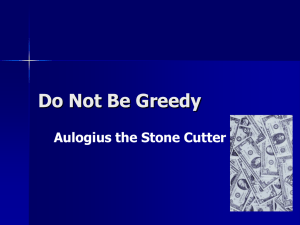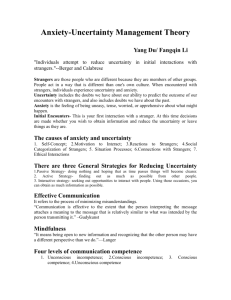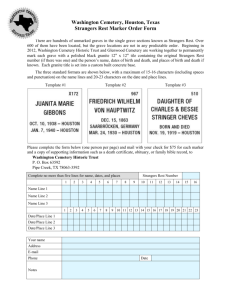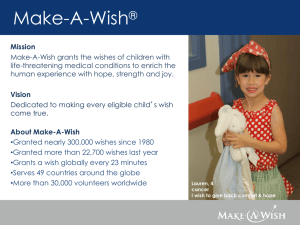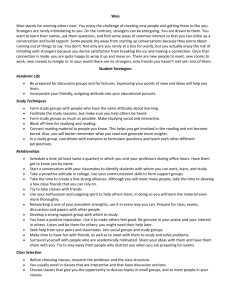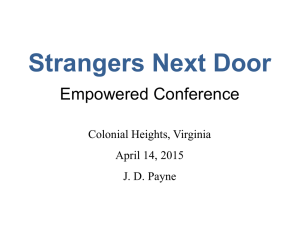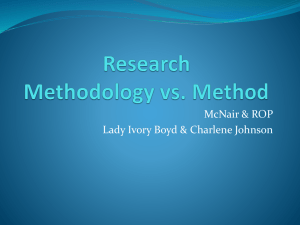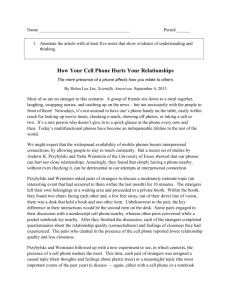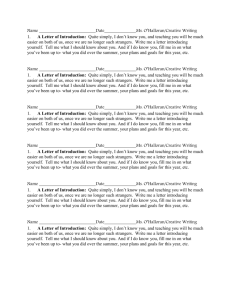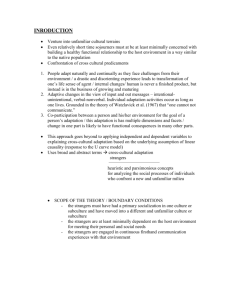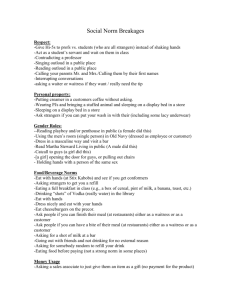I Knew You Before I Met You
advertisement
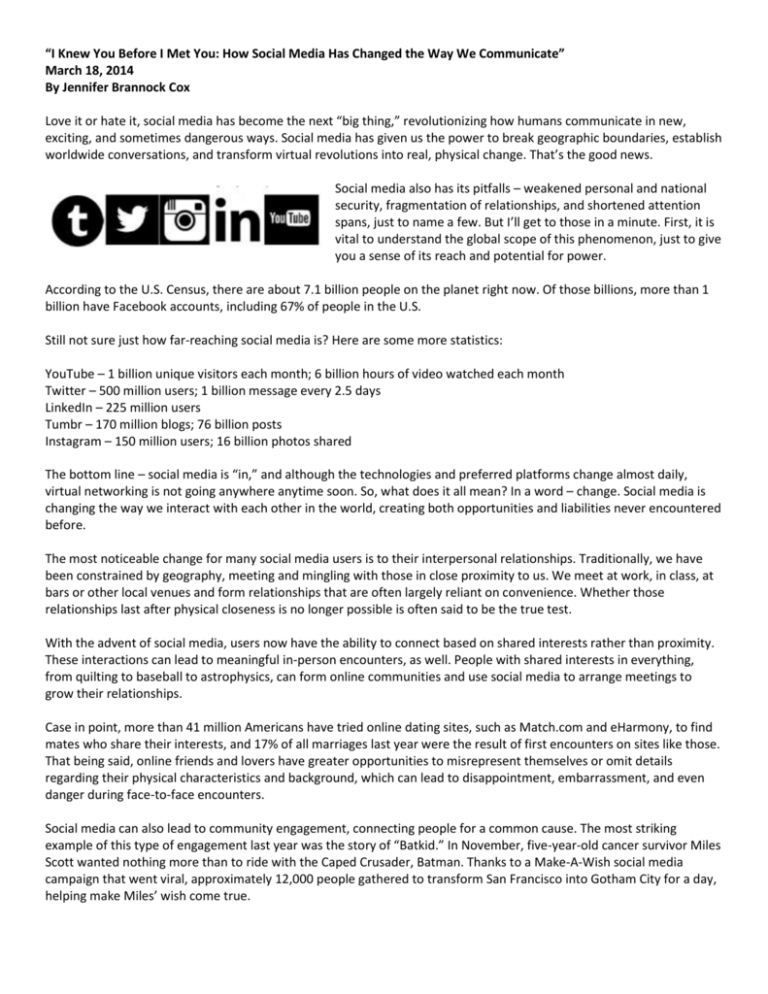
“I Knew You Before I Met You: How Social Media Has Changed the Way We Communicate” March 18, 2014 By Jennifer Brannock Cox Love it or hate it, social media has become the next “big thing,” revolutionizing how humans communicate in new, exciting, and sometimes dangerous ways. Social media has given us the power to break geographic boundaries, establish worldwide conversations, and transform virtual revolutions into real, physical change. That’s the good news. Social media also has its pitfalls – weakened personal and national security, fragmentation of relationships, and shortened attention spans, just to name a few. But I’ll get to those in a minute. First, it is vital to understand the global scope of this phenomenon, just to give you a sense of its reach and potential for power. According to the U.S. Census, there are about 7.1 billion people on the planet right now. Of those billions, more than 1 billion have Facebook accounts, including 67% of people in the U.S. Still not sure just how far-reaching social media is? Here are some more statistics: YouTube – 1 billion unique visitors each month; 6 billion hours of video watched each month Twitter – 500 million users; 1 billion message every 2.5 days LinkedIn – 225 million users Tumbr – 170 million blogs; 76 billion posts Instagram – 150 million users; 16 billion photos shared The bottom line – social media is “in,” and although the technologies and preferred platforms change almost daily, virtual networking is not going anywhere anytime soon. So, what does it all mean? In a word – change. Social media is changing the way we interact with each other in the world, creating both opportunities and liabilities never encountered before. The most noticeable change for many social media users is to their interpersonal relationships. Traditionally, we have been constrained by geography, meeting and mingling with those in close proximity to us. We meet at work, in class, at bars or other local venues and form relationships that are often largely reliant on convenience. Whether those relationships last after physical closeness is no longer possible is often said to be the true test. With the advent of social media, users now have the ability to connect based on shared interests rather than proximity. These interactions can lead to meaningful in-person encounters, as well. People with shared interests in everything, from quilting to baseball to astrophysics, can form online communities and use social media to arrange meetings to grow their relationships. Case in point, more than 41 million Americans have tried online dating sites, such as Match.com and eHarmony, to find mates who share their interests, and 17% of all marriages last year were the result of first encounters on sites like those. That being said, online friends and lovers have greater opportunities to misrepresent themselves or omit details regarding their physical characteristics and background, which can lead to disappointment, embarrassment, and even danger during face-to-face encounters. Social media can also lead to community engagement, connecting people for a common cause. The most striking example of this type of engagement last year was the story of “Batkid.” In November, five-year-old cancer survivor Miles Scott wanted nothing more than to ride with the Caped Crusader, Batman. Thanks to a Make-A-Wish social media campaign that went viral, approximately 12,000 people gathered to transform San Francisco into Gotham City for a day, helping make Miles’ wish come true. Not only did social media play a role in the organization of Batkid’s dream day; it garnered unprecedented recognition for the Make-A-Wish Foundation, which could assist in making many more dreams come true. Batkid’s day of fighting crime was shared across all forms of social media in 117 countries. The result: more than 400,000 tweets in one day, more than 21,000 Instagram and Twitter photos, and a 1,400% increase in traffic on the Make-A-Wish website during the day. Some social scientists have argued social media has actually lead to a decrease in community engagement, with more people staying online rather than meeting to participate. While that might be true of some, social media has the potential to unite neighbors for a common goal faster than any meeting or petition ever could. Social media has also changed the construction and dissemination of popular culture. Traditionally, decisions about what was to be popular were made by mass media executives based on their perceptions about what the general public might like. With the rise of YouTube, blogs, and other platforms for displaying talents, opinions, and ideas, the consumer has become the producer, gaining fame and popularity based on their actual mass appeal rather than the prediction of it. As captivating as 6 billion hours of YouTube can be, it can also be very distracting. Millions of Americans regularly visit social media sites during working hours, leading to decreases in productivity. Additionally, a recent study found constant connectivity online has lead to increases in depression among college-age students, as students find it difficult to look away from the computer and focus on other productive endeavors. Going beyond entertainment and personal use, social networking sites have been responsible for revolutions on national and international scales. In his attempts to organize the “Occupy Wall Street” protests, Change.org founder Ben Rattray relied heavily on social media sites to rally participants. Rattray told the Huffington Post, “The best way to get people away from their computer is through the computer; you can’t organize thousands of people in New York City [the way Occupy Wall Street has] without the web.” Social media was also credited for the political revolutions in Tunisia, Egypt, and Libya in early 2011, known as the “Arab Spring.” When dissidents’ opposition to leadership regimes were silenced in public, they took to sites like Twitter and Facebook to spread their messages and organize protests that eventually toppled the governments in those countries. Meanwhile, the rest of the world marveled, following issues they didn’t know existed and watching these revolutions in real time from the perspectives of those fighting. However, as these countries remain in turmoil, the real meaning and impact of those communications has yet to be determined. While there are different opportunities and challenges for communication on social media, the takeaway is this: social media connects strangers. On an interpersonal level, we connect with people who share our interests. As a community, we connect with neighbors who might otherwise be strangers. In pop culture, social media creates common ground for strangers to share and reflect. And globally, social media prompts strangers to unite when there is seemingly no other way. When we connect as strangers, we have unprecedented opportunities for positive change and union. However, we also open the door for reckless behavior that can put our identities, and even our lives, in danger. Social media sites offer us the opportunity to express ourselves in new ways, but they also create potential for us to harm ourselves. In a fit of anger, you might post something offensive on social media, or to be funny, a friend might post an embarrassing video of you. Inappropriate postings have cost people their friends, loved ones, and even careers. Even if you are not on social media, information posted about you could also have potentially damaging consequences that are beyond your control. More frightening is the ability to track people on social media. Many sites have geographic tags that allow others to see where users are when they post. Entertainer Jack Vale recently spooked social media users during an experiment by searching for people who had tagged themselves in his vicinity. He looked on their profiles, gathered some basic facts and personal information about them, and confronted them in public. Although the result was humorous, the implications were not lost on his startled victims, who did not realize how easily they could be found and how much information they were letting strangers know about themselves. With all its potential and pitfalls, social media makes for a fascinating study in human communication. As even more people adopt social media as an important, if not primary, tool for communicating, study of its possibilities and impact will likely continue to take center stage as researchers grapple for a snapshot of these sites during their coming of age. Whether social media is for you is up to you, but one thing is for sure – it cannot be ignored. As educators, it is vital that we recognize its permeation among students. Even if professors chose not to integrate social media into their classes, we have to acknowledge the prospects and problems social media creates for our students and ourselves. You never know when a video of you might appear on YouTube or what your students are tweeting about during class….
